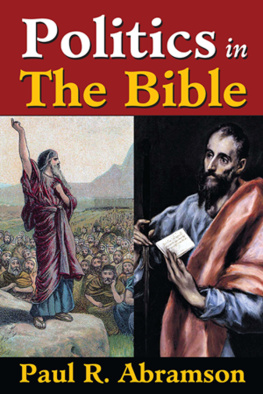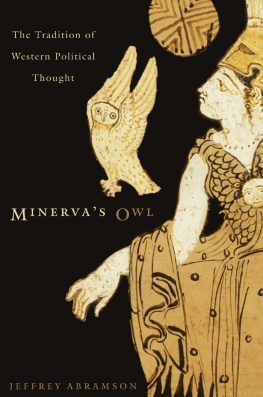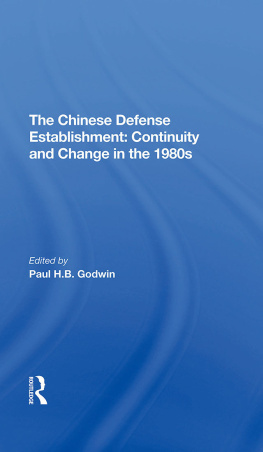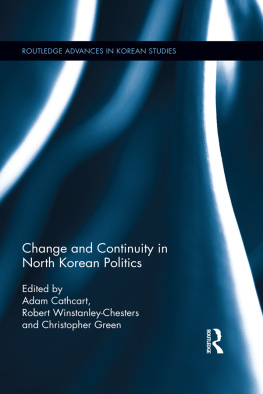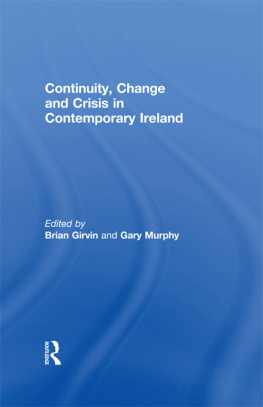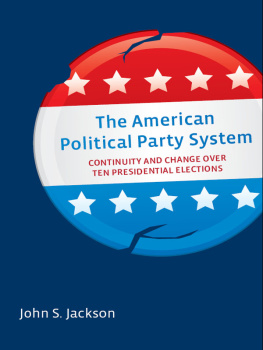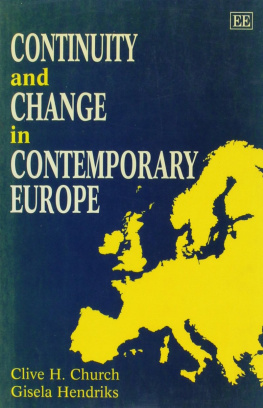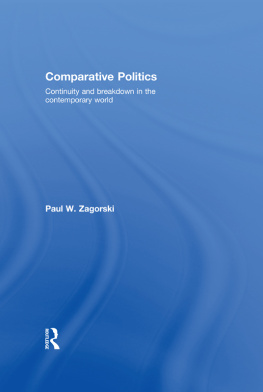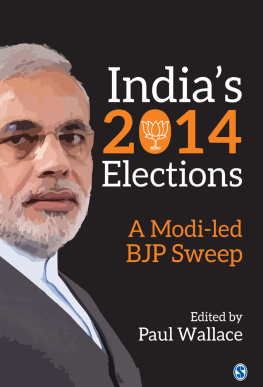Paul R. Abramson et al. - Change and Continuity in the 2012 and 2014 Elections
Here you can read online Paul R. Abramson et al. - Change and Continuity in the 2012 and 2014 Elections full text of the book (entire story) in english for free. Download pdf and epub, get meaning, cover and reviews about this ebook. year: 2015, publisher: SAGE Publications, genre: Science / Politics. Description of the work, (preface) as well as reviews are available. Best literature library LitArk.com created for fans of good reading and offers a wide selection of genres:
Romance novel
Science fiction
Adventure
Detective
Science
History
Home and family
Prose
Art
Politics
Computer
Non-fiction
Religion
Business
Children
Humor
Choose a favorite category and find really read worthwhile books. Enjoy immersion in the world of imagination, feel the emotions of the characters or learn something new for yourself, make an fascinating discovery.
- Book:Change and Continuity in the 2012 and 2014 Elections
- Author:
- Publisher:SAGE Publications
- Genre:
- Year:2015
- Rating:4 / 5
- Favourites:Add to favourites
- Your mark:
- 80
- 1
- 2
- 3
- 4
- 5
Change and Continuity in the 2012 and 2014 Elections: summary, description and annotation
We offer to read an annotation, description, summary or preface (depends on what the author of the book "Change and Continuity in the 2012 and 2014 Elections" wrote himself). If you haven't found the necessary information about the book — write in the comments, we will try to find it.
Change and Continuity in the 2012 and 2014 Elections — read online for free the complete book (whole text) full work
Below is the text of the book, divided by pages. System saving the place of the last page read, allows you to conveniently read the book "Change and Continuity in the 2012 and 2014 Elections" online for free, without having to search again every time where you left off. Put a bookmark, and you can go to the page where you finished reading at any time.
Font size:
Interval:
Bookmark:
To our wives:
Janet, Cindy, Angelle, and Barb

- Paul R. Abramson
- Michigan State University
- John H. Aldrich
- Duke University
- Brad T. Gomez
- Florida State University
- David W. Rohde
- Duke University


FOR INFORMATION:
CQ Press
An Imprint of SAGE Publications, Inc.
2455 Teller Road
Thousand Oaks, California 91320
E-mail: order@sagepub.com
SAGE Publications Ltd.
1 Olivers Yard
55 City Road
London EC1Y 1SP
United Kingdom
SAGE Publications India Pvt. Ltd.
B 1/I 1 Mohan Cooperative Industrial Area
Mathura Road, New Delhi 110 044
India
SAGE Publications Asia-Pacific Pte. Ltd.
3 Church Street
#10-04 Samsung Hub
Singapore 049483
Copyright 2016 by CQ Press, an Imprint of SAGE Publications, Inc. CQ Press is a registered trademark of Congressional Quarterly Inc.
All rights reserved. No part of this book may be reproduced or utilized in any form or by any means, electronic or mechanical, including photocopying, recording, or by any information storage and retrieval system, without permission in writing from the publisher.
Printed in the United States of America
Cataloging-in-publication data is available for this title from the Library of Congress.
ISBN 978-1-5063-0587-5
This book is printed on acid-free paper.

Acquisitions Editor: Sarah Calabi
Editorial Assistant: Raquel Christie
Production Editor: Laura Barrett
Copy Editor: Judy Selhorst
Typesetter: C&M Digitals (P) Ltd.
Proofreader: Eleni Georgiou
Indexer: Wendy Allex
Cover Designer: Janet Kiesel
Marketing Manager: Amy Whitaker
On November 6, 2012, Democrat Barack Obama was reelected president of the United States. Obamas narrow popular-vote majority victory over the Republican nominee, former Massachusetts Governor Mitt Romney, marked the first time that Democrats had won back-to-back majorities in presidential elections since Franklin D. Roosevelt in 1944. The Democrats gained two Senate seats in 2012, allowing the party to retain its majority status in the upper chamber. The Democrats also gained eight seats in the House of Representatives, but the Republicans maintained a sizeable majority and thus control of that body.
In the short term, the continuance of divided partisan control of government limits the prospects for significant policy changes during Obamas second term. Yet some view the 2012 election as a consolidation of a long-term Democratic majority, one that could forge public policy at the national level for decades to come. Democrats have now won the popular vote in five of the last six presidential elections. The party currently draws support from a coalition of the highly educated, women, African Americans, and Latinos. The latter two groups are expected to increase as a share of the U.S. population over the next twenty years, and electoral participation among both groups has increased steadily in recent years. Yet any talk of a long-term electoral advantage for the Democrats presupposes that current voters will maintain their loyalties to the two political parties and that group allegiances will be stable over time. The past shows that this can be a tenuous assumption.
Is America in the midst of an electoral transformation? What were the sources of Obamas victory in 2012, and how do they differ from Democratic coalitions of the past? Does his victory signal a long-term negative trajectory for Republicans chances in presidential elections? And are the electoral forces at play in presidential elections similar to those that structure congressional elections? These are the sorts of questions that we seek to answer here.
In our study of the 2012 elections, we rely on a wide variety of evidence. Because the bulk of our analysis focuses on individuals voting decisions, we rely extensively on survey evidencefour surveys in particular. In studying voter turnout, we employ the Current Population Survey (CPS) conducted by the U.S. Census Bureau. The CPS provides information on the registration and voting behavior of more than 133,000 individuals from more than 80,000 households. In examining voting patterns, we rely heavily on a survey of more than 26,000 voters interviewed as they exited the voting booths; this survey, conducted by Edison Research for a consortium of news organizations, is commonly referred to as the pool poll. We employ pool poll data in our analysis of the 2014 congressional midterm elections as well. These data were also collected by Edison Research and reflect a combination of exit and telephone interviews with more than 19,000 voters. In studying the party loyalties of the American electorate, we also analyze data from the General Social Survey (GSS) conducted by the National Opinion Research Center at the University of Chicago, which measured party identification twenty-seven times from 1972 through 2008, usually relying on about 1,500 respondents.
Our main source of survey data is the 2012 American National Election Studies (ANES) survey based on 2,054 face-to-face interviews conducted before the 2012 election and 1,929 interviews conducted after the election, using the version of the data released for analysis on June 10, 2013. This 2012 ANES is part of an ongoing series funded mainly by the National Science Foundation. These surveys, carried out originally by a team of scholars at the University of Michigan, began with a small study of the 1948 election; the first major study was in 1952. The ANES investigative team has studied every subsequent presidential election, as well as all thirteen midterm elections from 1954 to 2002. The 2012 ANES was conducted jointly by Stanford University and the University of Michigan. In the course of our book, we use data from all thirty surveys conducted between 1948 and 2012.
The ANES data are available to scholars throughout the world. Although we are not responsible for the data collection, we are responsible for our analyses. The scholars and staff at the ANES are responsible for neither our analyses nor our interpretation of these data. Similarly, the organizers and researchers of the CPS, GSS, and national pool poll bear no responsibility for our analyses or interpretation.
Many people assisted us with this study. We deeply appreciate the hard work of our research assistants, Mark Dudley and Joshua Lerner at Duke University and Megan Wiggins and David Macdonald at Florida State University. Mark assisted .
We would also like to thank Lee J. Abramson, who assisted us with the calculation of the issue preferences of the electorate found in .
In our study of turnout, we were greatly assisted by Michael P. McDonald of the University of Florida, who for several years has provided scholars with a valuable resource on voter turnout. McDonalds website, the United States Elections Project (http://www.electproject.org), presents detailed national- and state-level estimates of voter turnout based on both voting-age and voting-eligible population estimates.
Font size:
Interval:
Bookmark:
Similar books «Change and Continuity in the 2012 and 2014 Elections»
Look at similar books to Change and Continuity in the 2012 and 2014 Elections. We have selected literature similar in name and meaning in the hope of providing readers with more options to find new, interesting, not yet read works.
Discussion, reviews of the book Change and Continuity in the 2012 and 2014 Elections and just readers' own opinions. Leave your comments, write what you think about the work, its meaning or the main characters. Specify what exactly you liked and what you didn't like, and why you think so.


